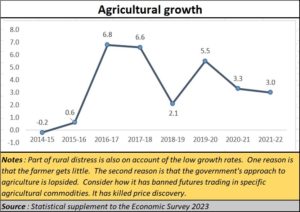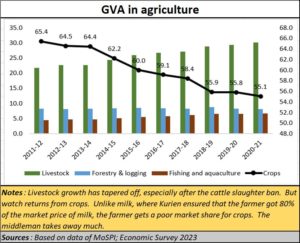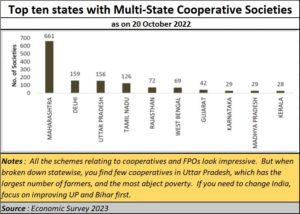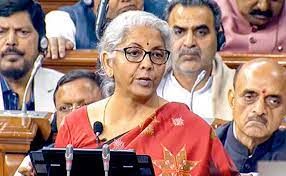Budget 2023 looks great, but has little for agriculture which accounts for half of India’s jobs
RN Bhaskar
 The claims are tantalizing. The budget proposals look wonderful. But much of the expectation of growth in the economy will eventually depend on purchasing power and consumption. Most analysts, being urbanites, have focussed on disposable income with urbanites.
The claims are tantalizing. The budget proposals look wonderful. But much of the expectation of growth in the economy will eventually depend on purchasing power and consumption. Most analysts, being urbanites, have focussed on disposable income with urbanites.
Rural India’s crippled purchasing power
But it is worth remembering that almost 50% of jobs are in the rural sector (https://asiaconverge.com/2023/01/2023-has-begun-badly-for-india/). If purchasing power does not increase in villages, economic growth will remain stunted, because 50% of the purchasing power in terms of people, gets muted.
The government’s own story looks positive. Here is what the Economic Survey 2023 states: “The performance of the agriculture and allied sector has been buoyant over the past several years, much of which is on account of the measures taken by the government to augment crop and livestock productivity, ensure certainty of returns to the farmers through price support, promote crop diversification, improve market infrastructure through the impetus provided for the setting up of farmer-producer organisations and promotion of  investment in infrastructure facilities through the Agriculture Infrastructure Fund. The chapter discusses these aspects while also focussing on other government interventions to enhance credit availability, facilitate mechanisation and boost horticulture and organic farming. “
investment in infrastructure facilities through the Agriculture Infrastructure Fund. The chapter discusses these aspects while also focussing on other government interventions to enhance credit availability, facilitate mechanisation and boost horticulture and organic farming. “
But for some time, forget the words, and look at the numbers. That is when the sense of discomfort begins to grow.
First there is no denying that credit for the rural sector has grown. But that credit has not resulted in greater prosperity. The farmer remains acutely distressed (https://asiaconverge.com/2022/12/the-government-prevents-farmers-from-being-self-reliant/).
Unimpressive growth
Second, investment in agriculture has remained pathetic. Look at agri gross capital formation (GCF). And this is where even talk about promoting agri start ups is not backed up by actual data. In the Lok Sabha, on 8 December 2022, the government stated (to  starred question No 833) that “ASPIRE (the mother company for agri startups) has a Fund of Funds component to support, through various Alternate Investment Funds (AIFs), investment in early stage MSME enterprises and startups in agro rural sector to improve manufacturing of products, supply chain, technology adoption and diversification, market penetration, etc. Till 30.11.2022, under ASPIRE Fund of Funds, 05 AIFs have invested Rs. 579.33 cr. in 91 agro rural based enterprises leading to an increase in turnover by Rs. 4278.77 cr. and creation of 6537 new jobs.” Just 5 companies creating 6,537 jobs – thus accounting for investments of Rs.9 lakh for the creation of each job. This is much higher than the Incremental Capital Output Ratios (ICOR) for the agri and allied sectors (https://asiaconverge.com/2023/01/what-budget-2023-should-focus-on/). Clearly, too much of money is being poured out for the creation of too few jobs. And the total output for India is far from impressive.
starred question No 833) that “ASPIRE (the mother company for agri startups) has a Fund of Funds component to support, through various Alternate Investment Funds (AIFs), investment in early stage MSME enterprises and startups in agro rural sector to improve manufacturing of products, supply chain, technology adoption and diversification, market penetration, etc. Till 30.11.2022, under ASPIRE Fund of Funds, 05 AIFs have invested Rs. 579.33 cr. in 91 agro rural based enterprises leading to an increase in turnover by Rs. 4278.77 cr. and creation of 6537 new jobs.” Just 5 companies creating 6,537 jobs – thus accounting for investments of Rs.9 lakh for the creation of each job. This is much higher than the Incremental Capital Output Ratios (ICOR) for the agri and allied sectors (https://asiaconverge.com/2023/01/what-budget-2023-should-focus-on/). Clearly, too much of money is being poured out for the creation of too few jobs. And the total output for India is far from impressive.
This is borne out by the charts which show the gross value added (GVA) for agriculture. Talk to experts in the milk industry. They will tell you that milk alone has the potential of raising income surpluses (all income less all expenditure) for farmers to Rs.100 per  cattlehead per day. But except in Gujarat, most politician owned milk cooperatives in Maharashtra pay their farmers a lot less. In Uttar Pradesh, there are hardly any milk cooperatives, leaving the farmers at the mercy of middle mean. UP pays one of the lowest prices for each litre of milk in the country. Moreover, the introduction of a cattle slaughter ban, without compensation for affected farmers, has only meant that their income sources have diminished, with the risk of spreading cattle diseases through old cattle. A visionary like Sodhi is asked to leave (https://asiaconverge.com/2023/01/sodhis-resignation-has-dire-warnings-for-agriculture-and-milk/), and in NDDB, the government is more eager to erase the name of Verghese Kurien (https://asiaconverge.com/2022/09/world-dairy-summit-forgets-verghese-kurien/).
cattlehead per day. But except in Gujarat, most politician owned milk cooperatives in Maharashtra pay their farmers a lot less. In Uttar Pradesh, there are hardly any milk cooperatives, leaving the farmers at the mercy of middle mean. UP pays one of the lowest prices for each litre of milk in the country. Moreover, the introduction of a cattle slaughter ban, without compensation for affected farmers, has only meant that their income sources have diminished, with the risk of spreading cattle diseases through old cattle. A visionary like Sodhi is asked to leave (https://asiaconverge.com/2023/01/sodhis-resignation-has-dire-warnings-for-agriculture-and-milk/), and in NDDB, the government is more eager to erase the name of Verghese Kurien (https://asiaconverge.com/2022/09/world-dairy-summit-forgets-verghese-kurien/).
That is why, even though the provisions in Budget 2023 look attractive, they seem divorced from ground realities.
Cooperatives
Just look at Uttar Pradesh. It has fewer cooperatives that Maharashtra. This affects the entire climate for farm prosperity. Consider the case of sugarcane. Politicians love to tell cane growers that they will increase the prices they get from sugar mills. Quite often, these prices are more than what the sugar mills can bear. In Maharashtra, the difference between what the politicians promise farmers, and the prices that mills can afford to pay, is  given back to sugar cooperatives as a subsidy from the government.
given back to sugar cooperatives as a subsidy from the government.
This is not the case in UP. Politicians announce higher cane prices. Mill owners who have not been allowed to create sugar cooperatives, cannot bear the new costs. The government too does not bail them out. So, they stop paying farmers. The state then threatens the mill owners with dire consequences. No wonder then, UP remains one of the most exploitative states for the farming community (https://asiaconverge.com/2022/02/the-double-engine-growth-for-uttar-pradesh-must-not-spread-over-india/). The distress is immense. Sadly, this state is governed by the ruling party, which could have ushered in policy changes aimed at farmer welfare. But there is little sign of that happening.
That is why, even the provisions for cooperatives – now controlled by the central government under the new laws for cooperatives — makes one worried about the plight of farmers.








































COMMENTS